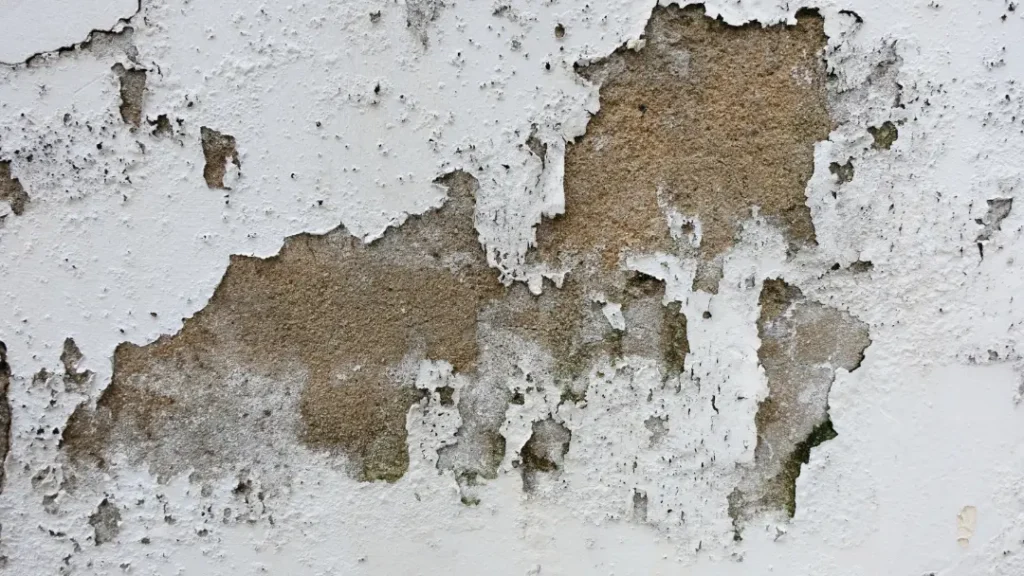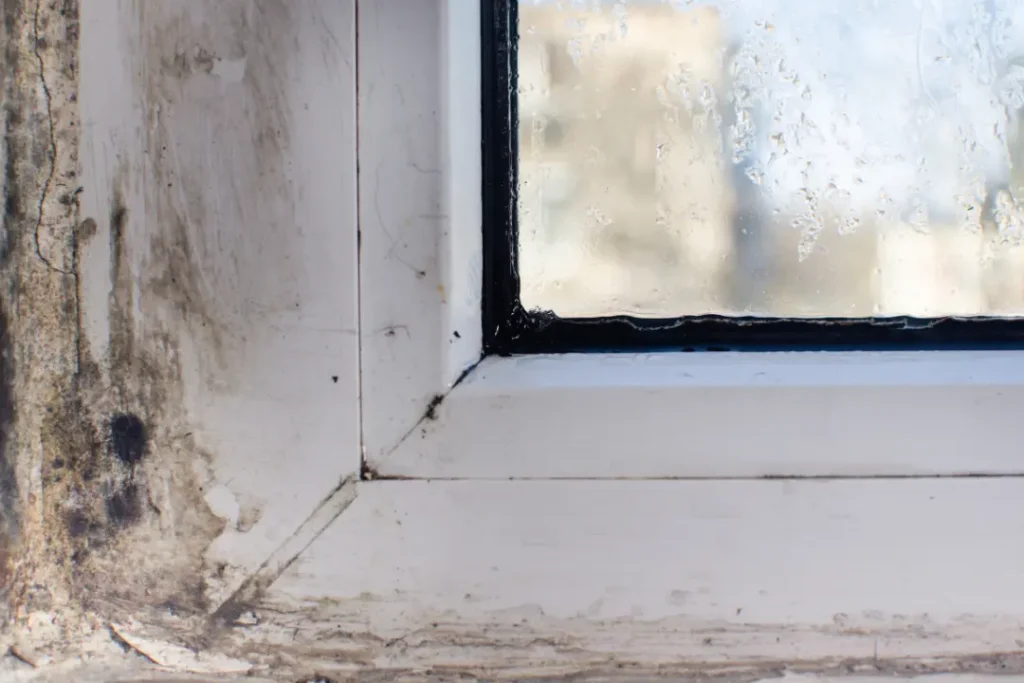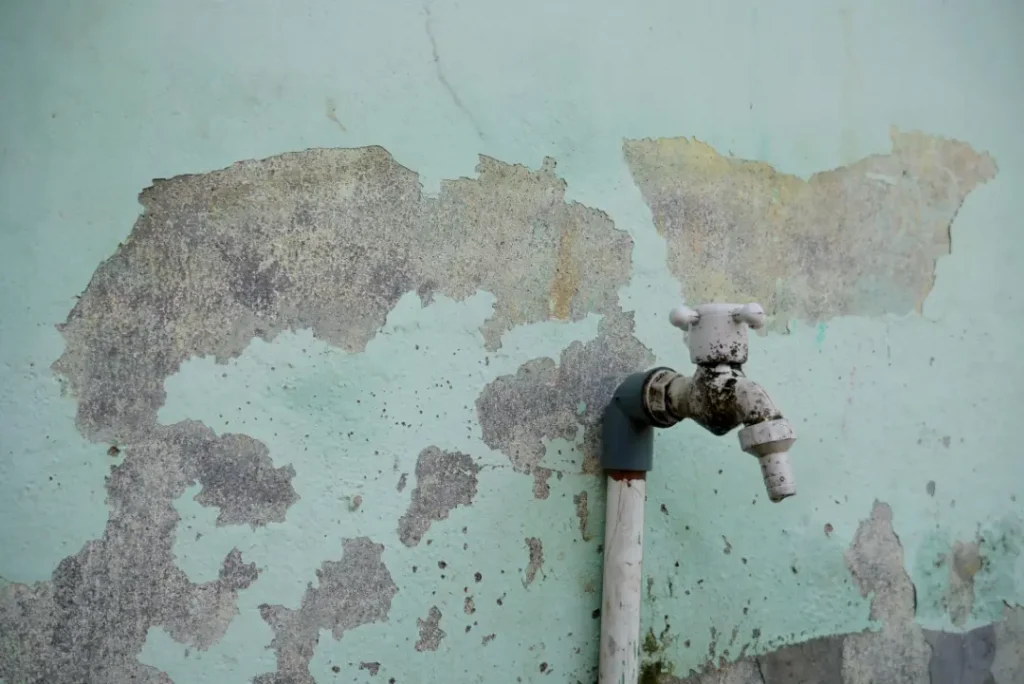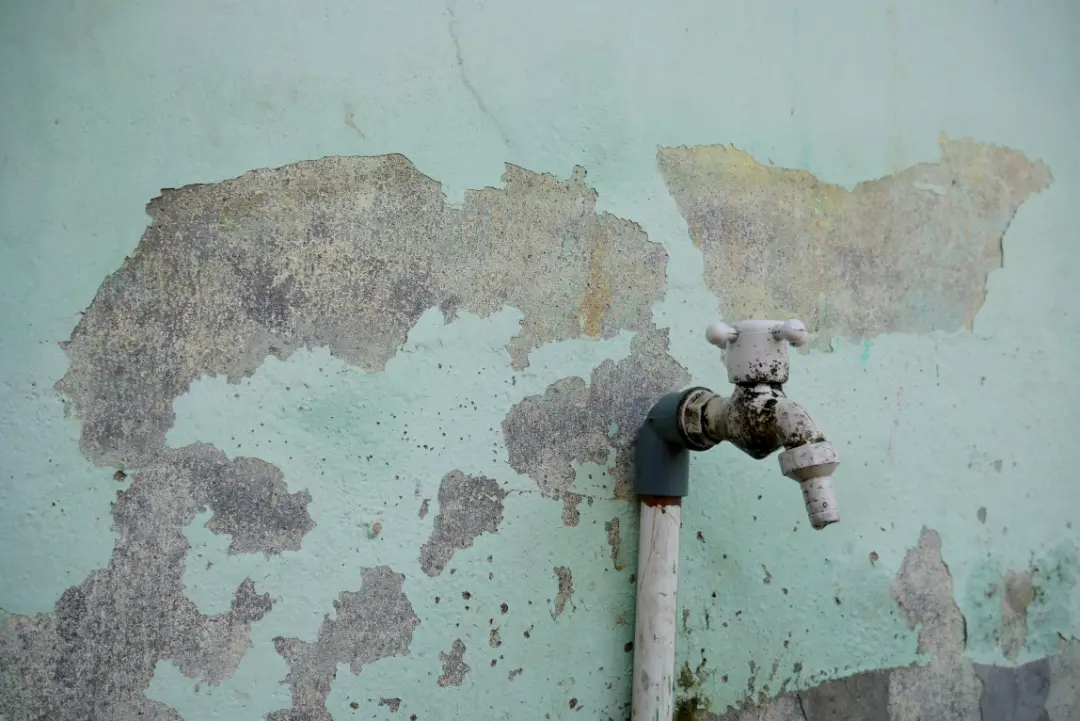Damp in homes can appear as rising damp, penetrating damp, or condensation damp. This guide explains the different types of damp, helping you identify and address them early to avoid damage and ensure a healthy home.
Key Takeaways
- Damp types include rising damp, penetrating damp, and condensation damp, each requiring specific identification and treatment methods.
- Ignoring damp can lead to structural damage, health issues, and reduced property value, emphasising the need for prompt intervention.
- Regular maintenance, inspections, and proper ventilation are crucial for preventing and addressing various damp problems in properties.
What Causes Damp in Properties?
Damp is a silent threat that, if ignored, can damage your home and health. It can undermine building structures and degrade indoor air quality. Damp is a complex issue with various underlying causes. Rising damp mainly affects older homes lacking a damp-proof course, allowing ground moisture to seep into the building. Problems with the DPC can include its absence or inadequate bridging, enabling moisture to bypass it.
Penetrating damp occurs when external water infiltrates a building, often due to plumbing leaks or structural faults. This leads to damp patches, peeling plaster, and discolouration near water sources.
Condensation damp happens when warm, moist air contacts cooler surfaces, leading to condensation. Understanding these causes aids in diagnosing and treating damp issues effectively.

Identifying Different Types of Damp
Identifying and treating dampness is crucial for maintaining property value and a safe living space. Damp can damage building materials and furnishings, leading to costly repairs. The three main types of damp found in houses are condensation damp, rising damp, and penetrating dampness.
Early identification of these signs allows for prompt action to mitigate damage.
Rising Damp
Rising dampness happens when groundwater rises through walls, typically prevented by a damp-proof course (DPC). This issue primarily impacts older homes, especially those built before 1875, often due to faulty or missing DPC and high ground levels.
Key signs of rising damp include:
- Tide marks
- Peeling paint
- Stains up to a metre high
- Damage to skirting boards
- A musty odour
Rising damp can weaken walls, damage plaster, and decrease property value if not addressed.
Preventing Rising Damp
Preventing rising damp involves ensuring that existing damp-proof courses are properly installed and maintained during renovations. Treating rising damp through improved building ventilation can significantly reduce the risk by allowing moisture to evaporate effectively.
Regular exterior inspections can help identify and rectify early signs of rising damp. Proper ventilation and maintaining an effective damp-proof course are key measures to prevent rising damp and ensure a healthy living environment.

Penetrating Damp
Penetrating damp involves water leaking through walls, roofs, or ceilings and spreading horizontally. It often results from external water infiltrating a building due to plumbing leaks or structural faults.
Solutions vary based on the cause and can often be resolved quickly and easily.
Regular maintenance and prompt repairs can prevent penetrating damp.
Common Signs of Penetrating Damp
Signs of penetrating dampness include damp patches on walls, watermarks, and deteriorating brickwork. Visible watermarks, peeling paint, and mould growth also indicate damp on walls.
Regular inspection of these signs is crucial to maintain property integrity. Small damp issues should not be overlooked, as ignoring them can lead to larger, more costly problems later on.
Condensation Damp
Condensation damp occurs when moisture builds up. This happens when warm air meets cool surfaces, causing water droplets to form. It’s most common in areas like kitchens, bathrooms, laundry rooms, and bedrooms.
If not taken care of, condensation damp can lead to mould growth and even structural damage. To manage it, you should keep your space warm, improve ventilation, and control humidity levels.
Symptoms of Condensation Damp
Symptoms of condensation damp include water droplets on windows, dark mould around them, and streak marks on walls. Everyday activities like cooking and washing add significant moisture to the air, contributing to condensation damp.
Early identification of these symptoms and taking preventive measures can effectively manage condensation damp.
Treating Condensation Damp
Proper ventilation is key in preventing condensation damp, achievable through trickle vents, extractor fans, and consistent heating. Extractor fans can significantly reduce moisture levels and help prevent condensation damp.
Implementing mechanical ventilation systems in new builds can effectively mitigate moisture problems and reduce condensation. Maintaining consistent heating helps manage condensation damp by avoiding extreme temperature fluctuations.
Hygroscopic Damp
Hygroscopic damp occurs when certain materials absorb moisture from the air due to hygroscopic salts and high humidity. It can be identified by damp patches that do not dry out and the presence of white, powdery salt deposits.
Hygroscopic damp can lead to mould growth and potential structural damage. Excess moisture and humid conditions exacerbate its symptoms and severity.
Managing Hygroscopic Damp
Dehumidifiers help manage moisture levels and reduce indoor humidity, which is crucial for effectively managing hygroscopic damp.
Proper ventilation helps circulate air and prevent humidity accumulation, ensuring adequate ventilation.
Plumbing Leaks and Damp
Damp from poor plumbing arise from leaks, drips, or drainage issues, often near fixtures like sinks or baths. Such dampness can also come from water and waste pipe leaks, especially in bathrooms and kitchens.
Damp patches from plumbing leaks stay wet regardless of external weather conditions. Once the leak is repaired, the affected area should gradually dry out and fade.

Fixing Damp from Plumbing Leaks
Wet patches on walls, ceilings, or floors and mould growth are signs of dampness caused by poor plumbing. Identifying and addressing dampness caused by plumbing leaks is essential for maintaining structural integrity and preventing health issues.
Damp areas often appear near sinks and baths and in wet patches on walls and ceilings. It’s important to address the issue promptly if you notice damp patches.
Construction Moisture
Newly constructed homes can retain significant moisture from materials like concrete and plaster, making them prone to dampness during the initial drying phase.
Damp from walls and floors drying out usually appears as patches that shrink over time as moisture evaporates. Effective moisture management during construction prevents structural damage and mould growth.
Controlling Construction Moisture
Using a damp-proof membrane and vapour barriers can prevent water ingress in buildings. Controlling moisture during construction is crucial to avoiding future damp-proof membrane problems.
Proper drying of construction materials is essential to avoid future damp-related issues.
Groundwater and Flooding Damp
Excess water from heavy rainfall, high water tables, and nearby bodies of water can lead to groundwater and flooding damp. This type of dampness can significantly damage foundations, walls, and flooring and promote mould and mildew growth.
If you suspect dampness in your property, consult a qualified building surveyor or damp specialist for advice.
Remediation of Groundwater Damp
A professional assessment is crucial for effectively addressing groundwater damp issues. Consulting experts ensure underlying problems are thoroughly evaluated.
Waterproofing solutions like membranes or sealants are commonly used to protect structures from moisture ingress. Effective drainage improvements help divert water from the property, reducing damp groundwater risks.
Secure Your Peace of Mind Today With Environ Property Services Meticulous
At Environ Property Services, we understand that damp issues can be overwhelming. Our dedicated team of experts is here to offer you tailored damp-proofing solutions designed to safeguard your home and well-being. Whether you’re dealing with rising damp, penetrating damp, or condensation, we approach every situation with care and urgency, ensuring that your living environment remains healthy and safe.
At Environ Property Services, we specialise in repairing and restoring London’s historical and contemporary buildings. We handle heritage works, extensive stone and brick restoration, intricate structural repairs, damp proofing, and damp surveys.
Our highly skilled specialists use their extensive knowledge to identify the exact type of damp affecting your property. With meticulous surveys and personalised treatments, we ensure your property receives the attention it deserves, giving you the peace of mind that only comes from knowing you’re in the hands of true professionals.
We Offer Expertise You Can Trust and Solutions You Can Rely On
When you choose Environ Property Services, you’re opting for unparalleled expertise. Our team consists of leading damp experts who are well-versed in treating period properties and historic structures. We understand the unique challenges these types of buildings present and have honed our skills to provide effective and gentle treatments that preserve their integrity.
With years of experience under our belt, we merge knowledge with compassion, listening to your concerns while providing solutions that fit your needs. Our commitment to quality means that every treatment is backed by guarantees and thorough follow-ups, ensuring lasting results that protect your investment for years to come.
Trust us to be your guiding light in resolving damp issues, as we are committed to delivering timely interventions that transform your property and restore your peace of mind. Contact us today, and let us help turn your damp concerns into a thing of the past.
Frequently Asked Questions
What are the common signs of rising damp?
Common signs include tide marks on walls, peeling paint, damp stains up to a metre high, damage to skirting boards, and a musty odour. Identifying these early can prevent long-term damage to your property.
How can I prevent condensation damp in my home?
Preventing condensation damp involves maintaining proper ventilation, using extractor fans, installing trickle vents, and maintaining consistent indoor temperatures to reduce moisture buildup on cool surfaces.
How do I know if I have damp caused by plumbing leaks?
Plumbing-related damp usually appears as wet patches near sinks, baths, or other fixtures, regardless of external weather conditions. Mould growth or persistent dampness near these areas is also a common indicator.
Why is it important to address damp issues promptly?
Ignoring dampness can lead to severe structural damage, mould growth, health problems, and a reduction in property value. Prompt intervention ensures the issue is resolved effectively, preserving both your home and well-being.
Conclusion
Addressing damp issues promptly and effectively is crucial to maintaining the structural integrity, health, and value of your property. By understanding the different types of damp you can take the necessary steps to prevent and treat these issues before they escalate. Regular inspections, proper ventilation, and timely repairs are key strategies for managing damp and creating a safe living environment.
Whether you’re dealing with minor signs of damp or significant damage, seeking professional assistance ensures the problem is handled thoroughly and accurately. Our expert services at Environ Property Services provide tailored solutions to safeguard your home and peace of mind. With the right approach, you can protect your property and enjoy a healthier, more comfortable space for years to come.

